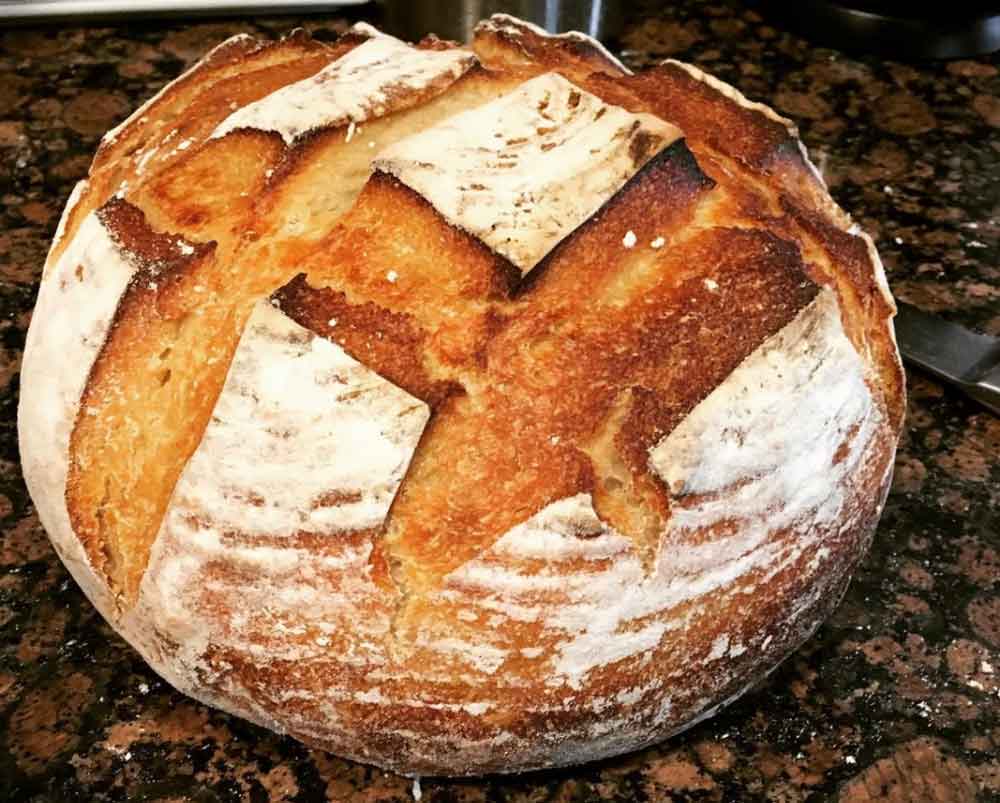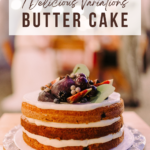Easy sourdough bread recipe! This recipe is awesome simple enough for the new baker and good enough to have even the most seasoned bakers impressed! Patience is key here sourdough is a labor of love but it is well worth the wait.
Easy Sourdough Bread Recipe:

Easy Sourdough Bread Recipe - Dutch Oven Sourdough
Equipment
- dutch oven
- oven
- large mixing bowl
Ingredients
- 1 cup sourdough starter
- 5 cups unbleached bread flour
- 1 Tbsp. Kosher salt
- 2 ¾ cups lukewarm water
- Cornmeal or semolina flour for dusting
Instructions
No kneading method:
- In a large mixing bowl combine by hand bread flour, starter, salt, and water; mix until just incorporated cover and rest for 1 hour.
- After the first hour of rest fold the dough under approximately 4 times to create a nice round shape on top. (don’t worry too much if it's not super pretty yet we will repeat this process 2 more times)
- Return the dough back into the bowl and repeat the folding a total of 3 times.
- After the dough has been folded a total of 3 times over the span of 3 hrs. Place the dough into a lightly greased bowl and cover well with plastic. Let ferment till doubled in size approximately 8 hrs. I do this step overnight in the refrigerator. If the room is cool, you can do this on the countertop, if it is really warm place it in the refrigerator.
- If your dough has been refrigerated pull it out and allow for it to warm up for at least 1 hr. before shaping.
- Shape dough into either 2 larger rounds or 4 smaller rounds.
- Place on a well-floured surface and lightly cover till the dough has doubled in size. Approximately 1 hr.
- Preheat oven to 425°F with the Dutch oven inside (to preheat the Dutch oven as well)
- Score the dough with a serrated knife.
- Dust the bottom of the sourdough with a mixture of 50/50 flour and semolina or cornmeal.
- Bake 450* F with the lid on for the first 23-30 min. then remove the lid to finish baking and get a golden color.
- Cool on a wire rack completely before slicing.
Become a Sourdough Superstar: The Ultimate Guide to Effortless Bread Magic
Are you ready to unlock the secrets of making mouthwatering sourdough bread? Don’t worry, it’s easier than you think! In this no-nonsense guide, we’re spilling the beans on an easy sourdough bread recipe that will have you baking like a pro. Say goodbye to intimidating baking jargon and hello to your new favorite hobby – making delicious bread from scratch.
Sourdough Starter From Scratch
Making a sourdough starter is like cultivating a little kitchen pet that helps your bread rise and brings out that delicious tangy flavor. Here’s how you do it: Mix equal parts of flour and water in a bowl. Cover the bowl loosely with a cloth and let it chill on your countertop. Every day, throw out half of the mixture and add fresh flour and water. After a few days, you’ll notice some bubbling action – that’s your starter coming to life! Keep feeding it daily until it’s doubled in size and smells pleasantly tangy. Congratulations, you’ve got yourself a lively sourdough starter ready to rock your bread-baking adventures! Just remember to give it regular feeds and it’ll be your baking sidekick for years to come.
Beneficial Bacteria
Keeping your sourdough starter safe and on the right track is essential for crafting delicious bread. To prevent harmful bacteria from taking over, maintain a consistent feeding schedule. Regularly discarding half of the starter and replenishing it with fresh flour and water helps create an environment where beneficial microbes thrive. Additionally, ensure proper hygiene by using clean utensils and containers. To guarantee the growth of the intended normal sourdough bacteria, use high-quality flour and water. Whole grain flours can introduce a broader spectrum of microorganisms, contributing to a diverse and vibrant starter. Observe your starter’s behavior – bubbly activity, pleasant aroma, and consistent rise after feedings are positive signs that your starter is on the right path.
Health Benefits
Sourdough bread is more than just a tasty treat – it’s packed with beneficial bacteria that can offer some health perks. These friendly microbes, often referred to as probiotics, are the same kind you might find in yogurt or other fermented foods. As sourdough ferments, these bacteria break down some of the bread’s components, making it easier for your body to digest and absorb nutrients. This process can potentially lead to better digestion and improved gut health. Moreover, the lactic acid produced during fermentation can help lower the bread’s glycemic index, which means it might cause a slower rise in blood sugar levels after consumption. So, indulging in a slice of sourdough isn’t just a delight for your taste buds – it could also be a boon for your gut and overall well-being!
Tips to Make Your Bread Extraordinary
Let’s sprinkle some sourdough wisdom to make your bread truly extraordinary. Ready? Let’s roll.
- Keep your room around 70-75°F (21-24°C) for perfect fermentation. It’s like a spa for your dough.
- Adjust your fermentation time based on room temp. Cooler room? Give it more time to rise.
- Feeling adventurous? Experiment with different starter-to-flour ratios for a flavor explosion.
- Check your dough’s rise by gently poking it – it should bounce back slowly like a memory foam mattress.
The Magic Ingredients
Now, let’s talk about the secret sauce – the ingredients that make your sourdough sing.
Active Sourdough Starter
Think of this as your dough’s BFF. It’s a mix of wild yeast and friendly bacteria that give your bread that amazing tangy taste.
All-Purpose Flour
This is your bread canvas, the foundation of all things fluffy. Mix it up with whole wheat or rye for extra pizzazz.
Warm Water
The water wakes up the yeast and sets the fermentation party in motion. Warm water gets the yeast grooving faster.
Easy Sourdough Bread Recipe Questions, Answered:
Q: Can I swap all-purpose flour with whole wheat?
A: Absolutely! Start small and swap a bit, then go wild as you get comfy.
Q: How do I know my sourdough starter is ready?
A: Look for a doubling in size within 4-6 hours after feeding. And that tangy smell? It’s the green light.
Q: Do I really need a fancy Dutch oven?
A: Nah, you can rock this with a baking stone or sheet. Just add steam for that crispy crust.
Q: How can I control the sourness level?
A: Play with fermentation time and temperature. Longer and cooler means tangier – find your sweet spot.
Q: Can I freeze my sourdough?
A: You bet! Slice before freezing and toast straight from the freezer or thaw it out.
Q: Why’s my bread sometimes dense?
A: It happens to the best of us. Over-kneading, short fermentation, or too much flour could be the culprit. Fold gently, give it time, and measure like a baking pro.
Easy Sourdough Bread Recipe Finale
Pat yourself on the back, you bread whiz! You’ve mastered the art of easy sourdough bread. With this recipe, some handy tips, and a sprinkle of experimentation, you’re ready to flaunt your homemade sourdough like a baking rockstar. So get out there, share your love for bread, and enjoy every delicious bite.







Yummy!